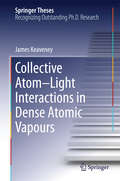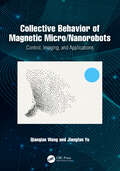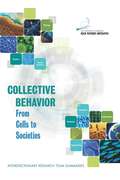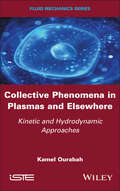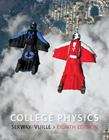- Table View
- List View
Collective Atom-Light Interactions in Dense Atomic Vapours (Springer Theses)
by James KeaveneyThe propagation of light in 'dense media' where dipole-dipole interactions play a role is a fundamental topic that was first studied in the work of Clausius, Mossotti, Lorenz and Lorentz in the latter half of the nineteenth century. However, until recently there remained some areas of controversy: for example, whereas the Lorentz model for a gas predicts a resonance shift, a discrete dipole model does not. This thesis makes the first combined measurement of both the Lorentz shift and the associated collective Lamb shift. This clear experimental result stimulated new theoretical work that has significantly advanced our understanding of light propagation in interacting media.
Collective Behavior in Complex Networked Systems under Imperfect Communication
by Jinde Cao Jianquan Lu Lulu Li Daniel W.C. HoThis book aims to explain how collective behavior is formed via local interactions under imperfect communication in complex networked systems. It also presents some new distributed protocols or algorithms for complex networked systems to comply with bandwidth limitation and tolerate communication delays. This book will be of particular interest to the readers due to the benefits: 1) it studies the effect of time delay and quantization on the collective behavior by non-smooth analytical technique and algebraic graph theory; 2) it introduces the event-based consensus method under delayed information transmission; In the meantime, it presents some novel approaches to handle the communication constraints in networked systems; 3) it gives some synchronization and control strategies for complex networked systems with limited communication abilities. Furthermore, it provides a consensus recovery approach for multi-agent systems with node failure. Also, it presents interesting results about bipartite consensus and fixed-time/finite-time bipartite consensus of networks with cooperative and antagonistic interactions.
Collective Behavior of Magnetic Micro/Nanorobots: Control, Imaging, and Applications
by Jiangfan Yu Qianqian WangCollective Behavior of Magnetic Micro/Nanorobots: Control, Imaging, and Applications reviews recent advances in the design and construction of magnetic collective micro/nanorobot systems, and promotes the bridging of the gap between their theoretical investigation and practical applications. By summarizing the recent progress in control, imaging, and biomedical applications of collective micro/nanorobots, the authors show the big picture of micro/nanorobotics and the roadmap of collective micro/nanorobots. They then discuss the control, imaging, and biomedical applications of collective micro/nanorobots, respectively, demonstrating the state-of-the-art techniques and ideas for designing systems of collective micro/nanorobots that can help researchers have a better understanding and further stimulate the development of such an exciting field. This book is suitable for scientists, engineers, and students involved in the study of robotics, control, materials, and mechanical/electrical engineering.
Collective Behavior: Interdisciplinary Research Team Summaries
by The National Academies Keck Futures Initiative"Collective Behavior" is the summary of the 2014 National Academies Keck Futures Initiative Conference on Collective Behavior. Participants were divided into fourteen interdisciplinary research teams. The teams spent nine hours over two days exploring diverse challenges at the interface of science, engineering, and medicine. The composition of the teams was intentionally diverse, to encourage the generation of new approaches by combining a range of different types of contributions. The teams included researchers from science, engineering, and medicine, as well as representatives from private and public funding agencies, universities, businesses, journals, and the science media. Researchers represented a wide range of experience - from postdoc to those well established in their careers - from a variety of disciplines that included science and engineering, medicine, physics, biology, economics, and behavioral science. The teams needed to address the challenge of communicating and working together from a diversity of expertise and perspectives as they attempted to solve a complicated, interdisciplinary problem in a relatively short time. This report highlights the presentations of the event and includes the team reports and pre-meeting materials.
Collective Dynamics of Particles: From Viscous to Turbulent Flows (CISM International Centre for Mechanical Sciences #576)
by Cristian MarchioliThe book surveys the state-of-the-art methods that are currently available to model and simulate the presence of rigid particles in a fluid flow. For particles that are very small relative to the characteristic flow scales and move without interaction with other particles, effective equations of motion for particle tracking are formulated and applied (e.g. in gas-solid flows). For larger particles, for particles in liquid-solid flows and for particles that interact with each other or possibly modify the overall flow detailed model are presented. Special attention is given to the description of the approximate force coupling method (FCM) as a more general treatment for small particles, and derivations in the context of low Reynolds numbers for the particle motion as well as application at finite Reynolds numbers are provided. Other topics discussed in the book are the relation to higher resolution immersed boundary methods, possible extensions to non-spherical particles and examples of applications of such methods to dispersed multiphase flows.
Collective Excitations in the Antisymmetric Channel of Raman Spectroscopy (Springer Theses)
by Hsiang-Hsi KungThis thesis contains three breakthrough results in condensed matter physics. Firstly, broken reflection symmetry in the hidden-order phase of the heavy-fermion material URu2Si2 is observed for the first time. This represents a significant advance in the understanding of this enigmatic material which has long intrigued the condensed matter community due to its emergent long range order exhibited at low temperatures (the so-called “hidden order”). Secondly and thirdly, a novel collective mode (the chiral spin wave) and a novel composite particle (the chiral exciton) are discovered in the three dimensional topological insulator Bi2Se3. This opens up new avenues of possibility for the use of topological insulators in photonic, optoelectronic, and spintronic devices. These discoveries are facilitated by using low-temperature polarized Raman spectroscopy as a tool for identifying optically excited collective modes in strongly correlated electron systems and three-dimensional topological insulators.
Collective Phenomena in Plasmas and Elsewhere: Kinetic and Hydrodynamic Approaches
by Kamel OurabahThe Universe is made up of systems consisting of a very large number of particles interacting in a very complex way. When studying these systems, a precise microscopic approach is unattainable. In practice, the best strategy is one that is able to “distinguish” between superfluous information and the information needed to make predictions about the evolution of the system. There are two main competing approaches: kinetic and hydrodynamic. Collective Phenomena in Plasmas and Elsewhere presents an overview of the theoretical bases of these kinetic and hydrodynamic approaches, but also discusses their limitations, the links between them and their extension to quantum mechanics and relativity. These methods were born in part out of the study of plasmas, but they also have more universal applications. A general framework for these approaches is outlined, followed by some applications in plasmas, gravitation, Bose–Einstein condensates and dark matter. Particular emphasis is placed on the analogies that can be made between all these different systems.
Collective Plasmon-Modes in Gain Media: Quantum Emitters and Plasmonic Nanostructures (SpringerBriefs in Physics)
by V. A. G. Rivera O. B. Silva Y. Ledemi Y. Messaddeq E. MaregaThis book represents the first detailed description, including both theoretical aspects and experimental methods, of the interaction of rare-earth ions with surface plasmon polariton from the point of view of collective plasmon-photon interactions via resonance modes (metal nanoparticles or nanostructure arrays) with quantum emitters (rare-earth ions). These interactions are of particular interest for applications to optical telecommunications, optical displays, and laser solid state technologies. Thus, our main goal is to give a more precise overview of the rapidly emerging field of nanophotonics by means of the study of the quantum properties of light interaction with matter at the nanoscale. In this way, collective plasmon-modes in a gain medium result from the interaction/coupling between a quantum emitter (created by rare-earth ions) with a metallic surface, inducing different effects such as the polarization of the metal electrons (so-called surface plasmon polariton - SPP), a field enhancement sustained by resonance coupling, or transfer of energy due to non-resonant coupling between the metallic nanostructure and the optically active surrounding medium. These effects counteract the absorption losses in the metal to enhance luminescence properties or even to control the polarization and phase of quantum emitters. The engineering of plasmons/SPP in gain media constitutes a new field in nanophotonics science with a tremendous technological potential in integrated optics/photonics at the nanoscale based on the control of quantum effects. This book will be an essential tool for scientists, engineers, and graduate and undergraduate students interested not only in a new frontier of fundamental physics, but also in the realization of nanophotonic devices for optical telecommunication.
Collector's Guide to Fort Payne Crinoids and Blastoids (Life of the Past)
by William MorganCollector's Guide to Fort Payne Crinoids and Blastoids is the first comprehensive guide for identifying the fossils of echinoderms from hundreds of millions of years ago, when North America was covered by a warm, equatorial sea.Crinoids and blastoids, echinoderms (the same family of marine animals to include starfish, sea urchins, and sand dollars) from the Fort Payne Formation in Kentucky, are rarely seen at gem, mineral, and fossil shows, nor are they regularly displayed at major museums. By combining high-quality color photographs and an accompanying descriptive text, William W. Morgan provides the first comprehensive identification guide to these fascinating fossils. Collector's Guide to Fort Payne Crinoids and Blastoids features photographs, often offering more than one view, of the best-quality specimens curated in the Smithsonian and other prominent invertebrate fossil museums. Morgan includes photographs that are unlabeled so that readers can test themselves to see whether they can differentiate some of the more subtle features that may be necessary for accurate identification.
College Algebra
by Carl Stitz Jeff ZeagerCollege Algebra: Third Corrected Edition (Precalculus, by Stitz and Zeager)
College Chemistry (Collins College Outlines)
by Steven Boone Drew H. WolfeThe Collins College Outline for College Chemistry is a comprehensive guide to the fundamental concepts behind chemical reactions, bonding, equilibria, and thermodynamics, with topics ranging from simple chemical measurements and the basics of atoms and molecules to entropy, electrochemistry, and nuclear chemistry. Fully revised and updated by Dr. Steven Boone, College Chemistry includes practical "test yourself" sections with answers and complete explanations at the end of each chapter. Also included are essential vocabulary definitions and sample exercises, as well as detailed images, charts, and diagrams.The Collins College Outlines are a completely revised, in-depth series of study guides for all areas of study, including the Humanities, Social Sciences, Mathematics, Science, Language, History, and Business. Featuring the most up-to-date information, each book is written by a seasoned professor in the field and focuses on a simplified and general overview of the subject for college students and, where appropriate, Advanced Placement students. Each Collins College Outline is fully integrated with the major curriculum for its subject and is a perfect supplement for any standard textbook.
College Physics
by Alan Van Heuvelen Eugenia Etkina Michael GentileCollege Physics is the first text to use an investigative learning approach to teach introductory physics. This approach encourages you to take an active role in learning physics, to practice scientific skills such as observing, analyzing, and testing, and to build scientific habits of mind. The authors believe students learn physics best by doing physics.
College Physics
by Jerry D. Wilson Anthony J. BuffaUsing step-by-step explanations of its worked examples, this text develops problem-solving skills. It also: emphasizes conceptual understanding, reinforced by examples; includes applications; and features a treatment that focuses on the essential core material.
College Physics
by Raymond A. Serway Jerry S. Faughn Chris Vuille Charles A. BennettNIMAC-sourced textbook
College Physics
by Raymond A. Serway Jerry S. Faughn Chris VuilleIntended for biology and social science students, this two-semester textbook explains Newtonian mechanics, the physics of fluid, heat and thermodynamics, wave motion and sound, the concepts of electricity and magnetism, the properties of light, relativity, and quantum physics. The eighth edition eliminates superfluous worked examples and adds sections on thermal processes and magnetic materials. Annotation ©2008 Book News, Inc. , Portland, OR (booknews. com)
College Physics
by Hugh Young Philip AdamsFor courses in College Physics. Help students see the connections between problem types and understand how to solve them For more than five decades, Sears and Zemansky's College Physics has provided the most reliable foundation of physics education for students around the world. With the 11th Edition, author Phil Adams incorporates data from thousands of surveyed students detailing their use and reliance on worked examples, video tutorials, and need for just-in-time remediation when working homework problems and preparing for exams. Driven by how students actually use the text and media today to prepare for their exams, the new edition adds worked examples and new Example Variation Problems in each chapter to help students see patterns and make connections between problem types. They learn to recognize when to use similar steps in solving the same problem type and develop an understanding for problem solving approaches, rather than simply plugging in an equation. The expanded problem types and scaffolded in-problem support help students develop greater confidence in solving problems, deepen conceptual understanding, and strengthen quantitative-reasoning skills for better exam performance. All new problems sets are available in Mastering Physics with wrong answer specific feedback along with a wealth of new wrong answer feedback, hints, and eTexts links with 20% of end of chapter problems.
College Physics
by OpenStaxThis introductory, algebra-based, two-semester college physics book is grounded with real-world examples, illustrations, and explanations to help students grasp key, fundamental physics concepts. This online, fully editable and customizable title includes learning objectives, concept questions, links to labs and simulations, and ample practice opportunities to solve traditional physics application problems.
College Physics
by Paul Peter Urone Roger HinrichsIn the new Second Edition of College Physics, Peter Urone succeeds in carrying out several goals: to convey the concepts of physics and to help students build the analytical skills to apply them; to help students gain an appreciation for the underlying simplicity and unity in nature; and to impart a sense of the beauty and wonder found in the physical universe. To accomplish these goals, Urone blends coverage of the traditional topics with modern material; and familiar ideas from modern physics, such as the existence of atoms and the conversion of mass into energy, are incorporated early. Topics are introduced conceptually with a steady progression to precise definitions and analytical applications. The analytical aspect (problem solving) is tied back to the concept before moving on to another topic. Urone uses a four-part example and problem-solving mechanism to improve students' skills in solving problems, as well as understanding underlying concepts. The human, biological, and medical applications throughout the text are an important aspect of College Physics, Second Edition. By using human applications throughout the text, Urone encourages conceptual and analytical understanding of the material.
College Physics (5th edition)
by Raymond A. Serway Jerry S. FaughnIntended for biology and social science students, this two-semester textbook explains Newtonian mechanics, the physics of fluid, heat and thermodynamics, wave motion and sound, the concepts of electricity and magnetism, the properties of light, relativity, and quantum physics. The eighth edition eliminates superfluous worked examples and adds sections on thermal processes and magnetic materials. Annotation ©2008 Book News, Inc. , Portland, OR (booknews. com)
College Physics (8th Edition)
by Raymond A. Serway Jerry S. Faughn Chris VuilleSerway (emeritus, James Madison U. ) and Vuille (Embry-Riddle Aeronautical U.) update yet again their textbook for a one-year introduction to physics for majors in biology, the health professions, environmental and social sciences, and technical fields such architecture. It uses algebra, geometry, and trigonometry but not calculus. The goal is for students to acquire a clear and logical understanding of the basic concepts and principles of physics, and some idea about how those can be applied to, and demonstrated from, aspects of daily life. This edition is fully integrated with Enhanced WebAssign. It covers mechanics, thermodynamics, vibrations and waves, electricity and magnetism, light and optics, and modern physics. Annotation ©2011 Book News, Inc., Portland, OR (booknews.com)
College Physics (Mindtap Course List Series)
by Raymond A. Serway Chris Vuille With contributions from John HughesSucceed in your course, improve your problem-solving skills, and enrich your understanding of the world around you with COLLEGE PHYSICS, Eleventh Edition! This proven text combines a logical presentation of physical concepts with a consistent strategy for solving problems and an unparalleled array of worked examples to help you master the concepts and skills of the course.
College Physics (Second Edition)
by Roger A. Freedman Todd G. Ruskell Philip R. Kesten David L. TauckFreedman College Physics, Second Edition, is a student-centered text and homework program for introductory, algebra-based physics courses. With a focus on conceptual understanding and biological applications, College Physics makes the relevance of physics clear to students. The Sapling Plus system combines the heavily researched FlipIt Physics prelectures (derived from smartPhysics) with a robust homework system, in which every problem has targeted feedback, a hint, and a fully worked and explained solution.
College Physics AP®
by Alan Van Heuvelen Eugenia Etkina Michael GentileThis correlates the College Board's Advanced Placement® Physics Curriculum Framework (effective Fall 2014) to the corresponding chapters and sections in College Physics, AP Edition.
College Physics Essentials, Eighth Edition: Electricity and Magnetism, Optics, Modern Physics (Volume Two)
by Jerry D. Wilson Anthony J. Buffa Bo LouThis new edition of College Physics Essentials provides a streamlined update of a major textbook for algebra-based physics. This is the second volume covers electricity, atomic, nuclear, and quantum physics. The first volume is available separately and covers topics such as mechanics, heat, and thermodynamics. The authors provide emphasis on worked examples together with expanded problem sets that build from conceptual understanding to numerical solutions and real-world applications to increase reader engagement. Including over 900 images throughout the two volumes, this textbook is highly recommended for students seeking a basic understanding of key physics concepts and how to apply them to real problems.
